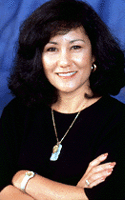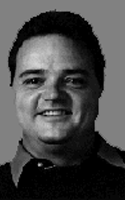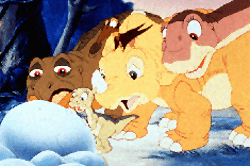Last November, Jeffrey Katzenberg asked Jim and Stephanie Graziano to head up production for DreamWorks' new television animation division. While the offer was not surprising, given the Graziano's track record, what was surprising is how readily they accepted...
Last November, Jeffrey Katzenberg asked Jim and Stephanie Graziano to head up production for DreamWorks' new television animation division. While the offer was not surprising, given the Graziano's track record, what was surprising is how readily they accepted. After all, their company, Graz Entertainment, noted for such hit shows as X-Men and The Tick, was one of the hottest studios in town.

DreamWorks Television Animation is the newest and so far least clearly defined of DreamWorks SKG, Hollywood's newest super studio. The division's mandate extends beyond only television to also include direct-to-video productions and interactive animation. The operation itself falls under the aegis of Steven Spielberg, whose previous TV efforts in collaboration with Warner Bros. (Tiny Toon Adventures, Animaniacs, Pinky and the Brain, etc.) helped revolutionize broadcast animation. Spielberg was known for his hands on involvement in these shows, which is likely to continue in the new venture. (In addition, former Disney Television Animation President Gary Krisel has been brought in to oversee the whole operation.)
Stephanie Graziano explained that, "We had three previous offers to buy the studio, but none of them made any sense. DreamWorks was the first case where we were offered things that we were lacking as a small studio. There was also the fact that it was a startup, which is always exciting, and that we could work together. That was really a big part of it."
Despite being one of Hollywood's most successful animation couples, Jim and Stephanie Graziano have not been able to work together as much as they would like. In fact, Jim had just returned to Graz after a three year stint at Universal Cartoon Studios when DreamWorks came along. Their longest stint together was not at Graz, but at Marvel Productions, where they met (in 1984) and married (in 1988)--he was Senior Vice President of Production and she worked under him as a producer.

Why Would We Even Want to Do It
People often ask us," Stephanie says, "about how we work together, or why we would even want to do it. But we really are at our best working together. We actually have different mind sets, but they end up complementing each other."
She explains that, "I come from the creative side, while Jim comes more from the technical end. So, in trying to find solutions to problems, we realize that not every person is the same. Some artists are better dealt with in a creative fashion, while others are better dealt with in a technical fashion. What we try to do is weigh these situations and decipher which direction would be more appropriate."
This difference also translates into different strengths vis-à-vis their roles at Graz. "When we started Graz," Stephanie notes, "we opened it with three work for hire series. I did all of the administrative work and Jim actually ran the studio. At that point, because it was really a function of his getting the production going, it was perfect. After the first six months, when he went to Universal and I took over the studio, the timing couldn't have been more perfect. The company had reached a point where it needed to start going after other properties and production deals. And that isn't what he does. Jim really does more of the day-to-day management and talent recruiting, while I'm better at making acquisitions and trying to build relationships with distributors and creators."

From Different Directions
Both Jim and Stephanie were born and raised in the Los Angeles area, but they came into animation and animation management from different directions.
For his part, Jim had bummed around a few years after graduating from the University of Idaho in 1975, where he had gone on a football scholarship (playing tight end) and majored in Physical Education. In 1978, he finally decided to get "a real job." As his father was a film editor with his own company, he "knew how to pop track and do a lot of other things. So, I got a job at Warner Bros. as an apprentice editor," eventually becoming "a full fledged editor." After he worked with Friz Freleng putting together such compilation films as Daffy Duck's Fantastic Island, he was hired in 1984 as studio production manager at Marvel Productions, where he stayed until 1991, eventually becoming Senior Vice President of Production. Those were Marvel's "big years," Jim recalls, "when they did The Transformers, Muppet Babies and My Little Pony."
On the other hand, Stephanie's entry into animation was (for a woman) more conventional. In 1972, right after high school, she got a job as an inker at Hanna-Barbera. She earned an A.A. degree in Advertising from Los Angeles Valley College, and went on to UCLA to study Fine Arts, all while continuing to work in animation. She recalls that, "I was at a point in the business where it was thriving. I was freelancing for two or three places, while working during the day at Hanna-Barbera. It became such a lucrative situation that I thought, 'Well, I can always go back to school!'"
She left college and decided to "pursue various avenues and tried to become more versatile." She became an ink and paint supervisor at Ruby-Spears, while, on her own, learned all she could about camera and editing.
At this time, American studios were beginning to send ink and paint to Asia in an effort to cut costs. She "did not really want the work to go over there, but I knew that it was going to happen and wanted to know exactly what they were capable of." Thus, she "volunteered three or four times to go overseas to set up shows for them."
Stephanie became studio manager for Tom Carter, before going to Marvel in 1984 as a production manager. Two years later, she got her first producing assignment (The Humanoids), and then started working in development with Margaret Loesch.
When Loesch left to start the Fox Children's Network, Stephanie went along as Director of Animation Programming and Production. When Jim started Graz in 1992, she stayed on at Fox, but helped him out with administrative tasks in her spare time. After Jim went to Universal, Stephanie stepped in to run Graz full-time.
Expanding the Studio
At Universal, Jim oversaw production on such shows as Beethoven, Shelly Duvall's Bedtime Stories and Earthworm Jim, along with three made-for-video sequels to The Land Before Time. Meanwhile, Graz, under Stephanie's direction, expanded from a studio for hire to the point where it had an ownership interest in half of its projects, as well as expande into such areas as home videos (Cathy), video games (Shadoan) and TV commercials.
At the same time, the animation market was also changing, as the industry was becoming increasingly dominated by the major studios. As a result, Stephanie says, "it will be interesting to see how small, independent studios who want to retain ownership survive in a market, where the big guys want to own everything. It was something that I really couldn't analyze at Graz, but it was something interesting to consider."
By last year, Graz had reached their long term goal of having an ownership interest in half their productions (with the other half being done on a for hire basis). Stephanie states that, "I didn't really see it getting too much bigger, or it probably wouldn't have been as enjoyable in the same way. I really anticipated it's future being more of a maintenance base than a growth base."

Jim concurs, feeling that while Graz would have been able to maintain its work flow and perhaps "grown a bit," but wonders what would have happened, with "all the big guns really gearing up."
For the Grazianos, their new position means stepping up from modest budgets set by clients, to dictating their own budgets and schedules. However, they plan to continue the same creator friendly approach that had contributed so much to Graz' success. In this, the Grazianos are part of a new generation of studio managers who have transformed the creative environment. As such, they have helped television animation, especially, turn away from the factory approach initially heralded by the likes of Hanna-Barbera in the early days of Saturday morning animation.

At Graz, there was a conscious effort to cast each artist for each show, while encouraging interaction between the crew in order to promote greater creativity. Stephanie notes that their new studio will be planned with "production units that will be defined by, in almost all cases, individual offices on the exterior. In almost all cases, individual offices, with a living room setting in the center. That will act as a meeting place, a communications center, with screening capabilities, that will encourage people to interact together and be part of a team." (It's interesting to note, in this regard, as Jim points out that, "there are no titles within any division of DreamWorks.")
Given the fact that no shows have yet been given the green light at DreamWorks Television Animation, it is too early to tell how the new operation will fare. But given its all-star management line up--including Jim and Stephanie--it is an operation which in many ways seems to have everything going for it.
Harvey Deneroff, in addition to his duties as Editor of Animation World Magazine, edits and publishes The Animation Report, an industry newsletter, which has taken over operation of the annual Ojai Animation Conference.







